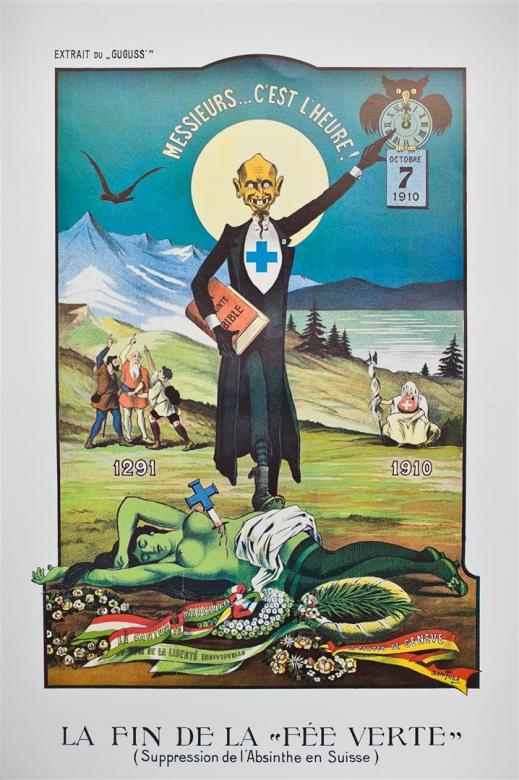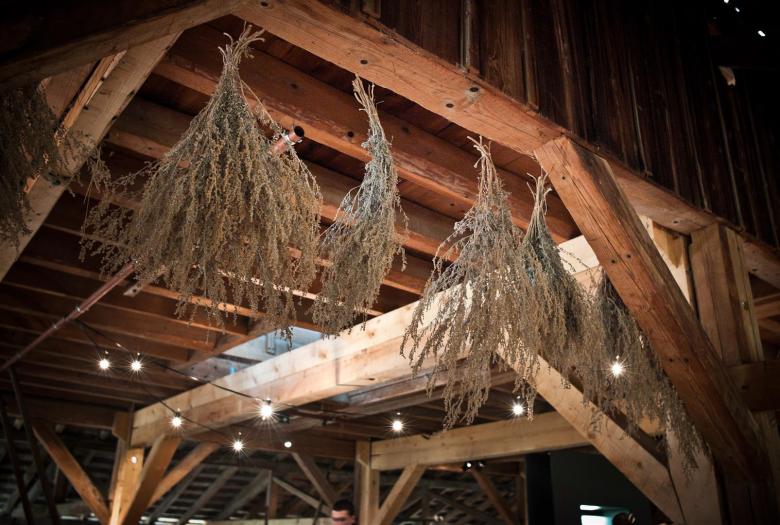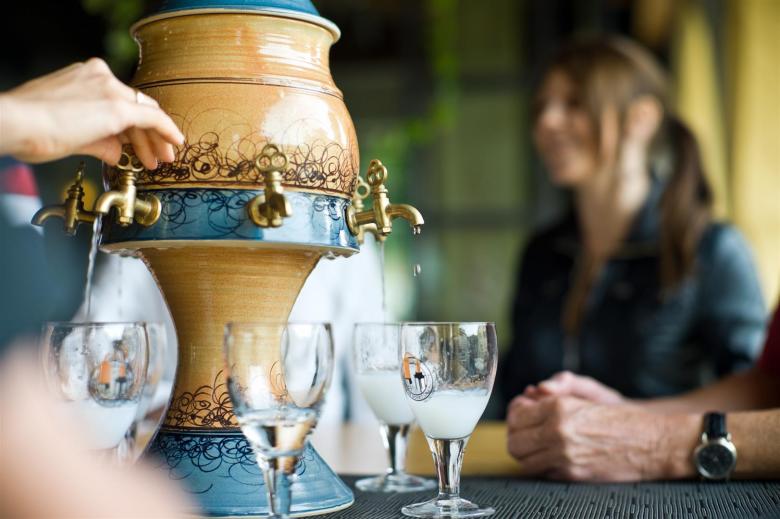Absinthe: Swiss local product leaves behind its shady past
Switzerland's Val-de-Travers is the birthplace of absinthe and has strong links to this local product that was banned for many years. An interactive exhibition in Môtiers in the canton of Neuchâtel tells its extraordinary story, while some distillers have set about seeking a PGI. We take a closer look at a spirit with a colourful past.
Absinthe, the famous distilled alcoholic beverage, is named after a medicinal plant with a bitter taste. Also known as la fée verte ('the green fairy'), this local product originates from the Val-de-Travers, a region in the canton of Neuchâtel that borders France. From the very beginning, the product had strong ties to both France and Switzerland, with distilleries on both sides of the border. It was banned for almost a century, during which time it was only sold on the black market, eventually emerging from the shadows in 2005 when it was legalised. Today, around twenty microdistilleries produce absinthe in the Val-de-Travers.
The first recipe is thought to have been invented by Mère Henriod in the mid-18th century to harness wormwood, a plant that is recommended for the treatment of digestive disorders. Absinthe is an alcohol obtained from distillation and contains the holy trinity of artemisia absinthium (grand wormwood), anise and fennel seeds. Added to this are various aromatic plants, such as green anise, lemon balm and hyssop, depending on the recipes, which are often closely guarded.

The green fairy: an artists' muse
In the 19th century, absinthe owed its reputation to the painters and poets who drunk it and featured it in their work. Its popularity in such circles brought it fame in Paris, which was the art capital of the world at the time, and its high-profile fans included the likes of Gauguin and Baudelaire. When it first appeared, absinthe was expensive, but it later became more affordable and the absinthe ritual appealed to all social classes. At l'heure verte (the green hour), fans would get together in cafés, sitting around their absinthe fountains as water was poured drop by drop over sugar cubes placed on perforated spoons made of silver.
The myth of the madness-inducing alcohol
This enthusiasm also sparked suspicion, and the green fairy made its fair share of enemies. Its detractors included the church, doctors involved in the fight against alcoholism, the press and... wine-growers (the competition!) A number of high-profile scandals shook public opinion and the crimes were blamed on absinthe. The popular belief was that the drink would make people go mad due to a molecule it contains called thujone. While absinthe does contain this molecule, it is only present in minuscule quantities, and recent studies have shown that scientifically it cannot be blamed for causing hallucinations or madness.
Clandestine activities
This dogged resistance resulted in absinthe being banned in Switzerland in 1910, and in France, Germany and the United States a few years later. But its production secrets were not lost during the 95-year ban. Swiss producers went underground and continued to make it in secret. This proved tricky, as the distillation process gives off a strong and distinctive odour...a perfume of resistance that would hang over the villages of the Val-de-Travers for almost a century. Stills were hidden in cellars and washtubs were tinkered with to be used for distilling. Absinthe connoisseurs knew where to go and the drink was sold on the black market – sometimes disguised as another spirit. Inspectors from the Swiss Alcohol Board played cat and mouse with the distillers for decades and were at times heavy-handed.

Absinthe was only legalised in Switzerland in 2005. Since then, distillers have been able to leave behind the clandestine life and do business in the open. Even now, some still export their products all over the world, particularly to the United States and Germany.
The race for a PGI
The epic tale of the green fairy is not over yet, however. In the Val-de-Travers, a number of distillers and plant producers have come together in a trade association to promote and develop activities linked to absinthe. Their current aim is to obtain the PGI "Absinthe du Val-de-Travers" for this local product. Claude-Alain Bugnon from the Artemisia distillery and a member of the association, explains that this is also about quality. He bemoans the fact that the absinthe manufacturing process is not currently set out in any Swiss law. He is concerned about non-distilled alcoholic beverages that are sold under the name absinthe and are often produced elsewhere in Europe. The association would also like to see distillers focus on plants from the Val-de-Travers region in their products in order to create maximum value for the local area. Grand and petite wormwood, lemon balm, hyssop and mint are all grown in the Neuchâtel valley. But these demands do not appeal to all producers.

© Guillaume Perret

© Guillaume Perret
A ritual is rediscovered
The accoutrements associated with absinthe, such as the fountain and the absinthe spoon, were abandoned when the beverage was banned for obvious reasons. But now that 'the green fairy' has emerged from the shadows, they too are part of the new absinthe craze. But how is this strange fountain used? A sugar lump is placed on the absinthe spoon, which rests on the rim of the glass. Water is then slowly poured from the fountain, drop by drop, causing the sugar cube to melt. This counteracts the bitterness of green absinthe, which is one variety of the drink. However, there is traditionally no need for sugar when tasting white absinthe, which is less bitter.

© Guillaume Perret
In search of the green fairy
For those who want to find out more, the story of this alcoholic beverage is told by the Maison de l'absinthe in Môtiers, an interactive exhibition that opened its doors in 2014. Anecdotes and artefacts illustrating the legend of absinthe and its clandestine period are displayed in an appealing and engaging way. Visitors can find out about the beverage's past, watch video accounts from iconic figures in absinthe's history and find out about the various plants needed to produce the spirit. The exhibition also features a unique bar, where visitors can taste 30 different varieties of absinthe. Another good tip for anyone visiting the Val-de-Travers is to go and meet a producer: there are several who organise tours of their microdistilleries in several languages.

© Tatiana Tissot
Finally, when going for a walk in the Val-de-Travers, it is not unusual to come across a bottle of 'the green fairy' by a fountain. These enigmatic and beautiful 'secret fountains', which are sometimes hidden deep in forests, allow hikers to enjoy a glass of absinthe mixed with spring water. According to legend, the bottles, which are usually hidden in carved wooden boxes, are concealed in the valley by absinthe lovers.




